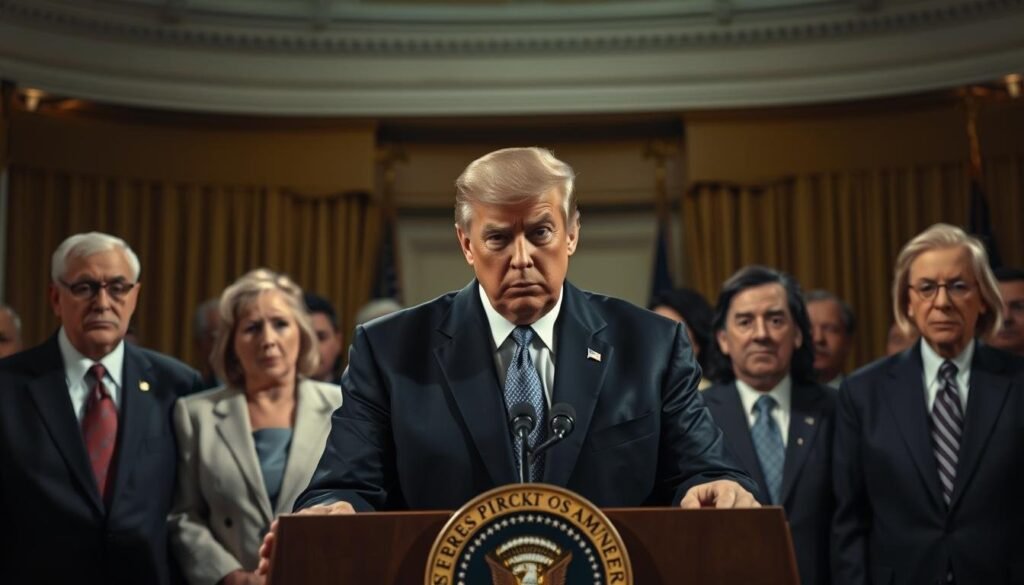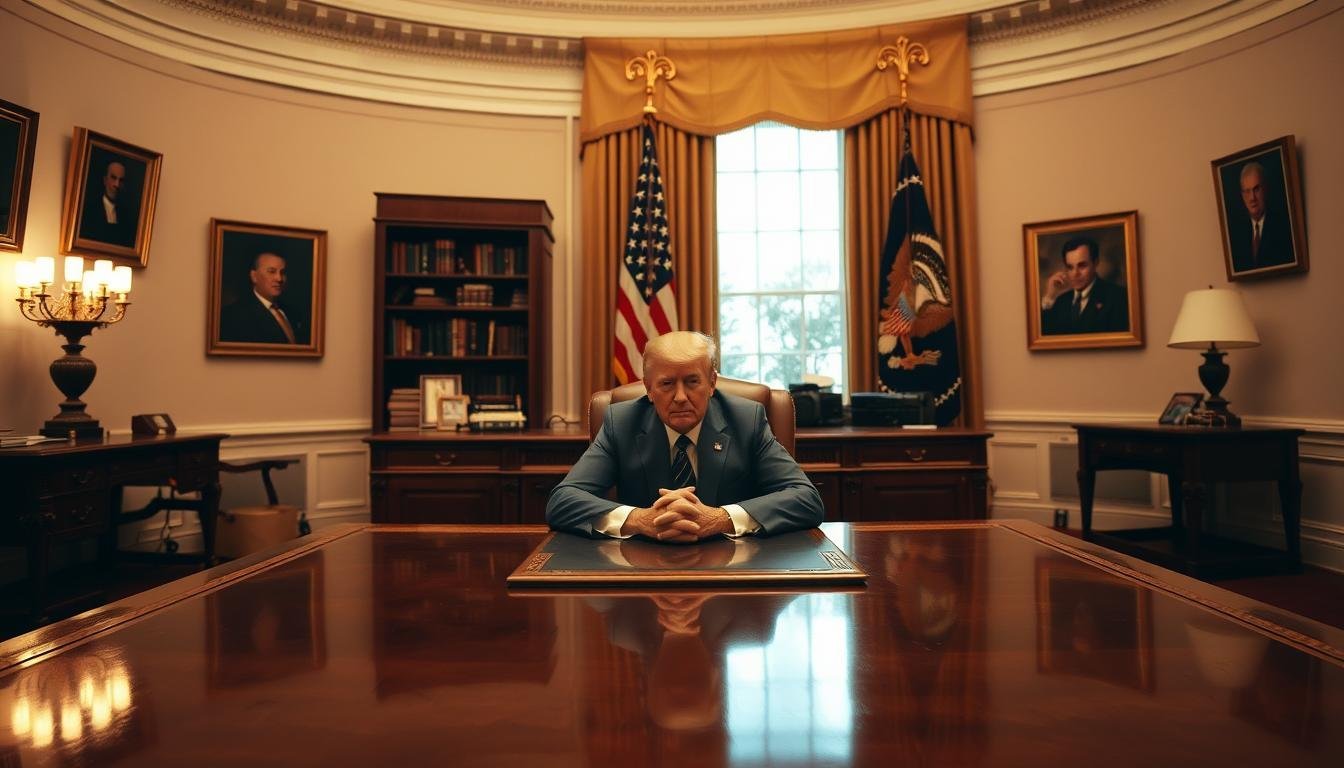Can the President Fire Executive Branch Employees? Have you ever wondered how much power the president has to hire and fire in the executive branch? It’s a complex issue. It involves balancing the president’s authority with the rights of employees.
Looking into this topic, it’s key to understand the constitutional framework. This framework outlines the president’s role. The president’s power to make personnel decisions is a big part of their authority.
Knowing how this works helps us understand the executive branch better. You’ll learn about the president’s powers and how they affect employees in the executive branch.
Contents
- 1 Presidential Powers and the Executive Branch
- 2 Structure of the Federal Workforce
- 3 Can the President Fire Executive Branch Employees?
- 4 Legal Limitations on Presidential Firing Power
- 5 Conclusion: Can the President Fire Executive Branch Employees?
- 6 FAQ
- 6.1 Can the President fire a Cabinet Secretary?
- 6.2 What are Schedule C appointments?
- 6.3 How do Senate-confirmed positions differ from other executive branch employees?
- 6.4 Can the President fire White House staff members?
- 6.5 What was the impact of Morrison v. Olson on presidential firing power?
- 6.6 How did Seila Law LLC v. Consumer Financial Protection Bureau affect the President’s firing authority?
- 6.7 Are there any statutory limitations on the President’s ability to fire executive branch employees?
- 6.8 Can executive branch employees challenge their termination in court?
Presidential Powers and the Executive Branch
Presidential powers are key to the executive branch’s work. The U.S. President has a lot of authority, thanks to the Constitution. This includes the power to hire and fire people in the executive branch.
The executive branch is huge, with many departments and agencies. The President must make sure it works well and follows the law.
The Constitution gives the President a lot of power over the executive branch. Article II, Section 2 says the President can nominate and appoint officials. This means the President has a lot of say in who works there.
Key Aspects of Presidential Powers
- Appointment and removal of executive branch employees
- Authority to direct the actions of executive branch departments and agencies
- Power to issue executive orders
The table below shows the structure of the executive branch. It highlights the President’s role and other important parts.
| Entity | Description | Role in Executive Branch |
|---|---|---|
| President | Head of the Executive Branch | Supervises and directs the executive branch |
| Cabinet | Advisors to the President | Provides counsel on major decisions |
| Executive Departments | Administrative units of the executive branch | Carry out the day-to-day work of the federal government |
In conclusion, the President has a lot of power in the executive branch. This power comes from the Constitution and laws. Knowing about these powers helps us understand how the executive branch works and who is in charge.
Structure of the Federal Workforce
The federal workforce is split into different groups, each with its own rules. Knowing these groups helps us understand who the president can fire in the executive branch.
The main groups are career civil servants and political appointees. Career civil servants are hired based on their skills and stay in their jobs through different administrations. Political appointees, on the other hand, are chosen by the president and may need Senate approval.
Senate-Confirmed Positions
Senate-confirmed positions are top jobs in the executive branch that need Senate approval. These include cabinet secretaries and other important officials. The Senate checks if the nominees are qualified and have the right policies.
Removing a cabinet secretary is a big deal. It not only changes who’s in charge but can also affect government programs. The president must think about the political and policy effects of such a move.
Schedule C appointments are political jobs that don’t need Senate approval. These roles are often for people who support the administration’s policies. They work in key positions like special assistants.
Unlike Senate-confirmed jobs, Schedule C appointments can be changed quickly. This means the president can make staff changes fast. But, these jobs are less secure than Senate-confirmed ones.
In summary, the federal workforce is complex with different types of employees and rules. Knowing about these groups helps us understand the president’s challenges when deciding to fire employees in the executive branch.
Can the President Fire Executive Branch Employees?
Many wonder if the president can fire cabinet secretaries and other executive branch employees anytime. The answer is not simple. It involves looking at the legal and practical sides of the president’s power.
Cabinet Secretaries and Agency Heads
The president has a lot of freedom in firing cabinet secretaries and agency heads. They can be let go without a reason. But, the president must follow certain steps and think about the political impact.
- Cabinet secretaries can be fired by the president, but this decision is often subject to political scrutiny.
- Agency heads, similarly, serve at the president’s discretion and can be removed if their policies or actions are not aligned with the administration’s goals.
- The process typically involves notifying the relevant congressional committees and may require some coordination with other branches of government.
White House Staff
The White House staff, including senior advisors and other key personnel, are also subject to the president’s hiring and firing authority. The president has a lot of freedom in managing the White House staff. These positions are usually considered to be at-will employment.
When firing White House staff, the president must consider a few things:
- The need to maintain a cohesive and effective team to support the administration’s agenda.
- The potential political fallout from dismissing high-profile staff members.
- The importance of ensuring a smooth transition of responsibilities when staff members leave.
In conclusion, the president has a lot of power to fire executive branch employees. This includes cabinet secretaries, agency heads, and White House staff. But, this power comes with its own set of limits and political effects. Understanding these complexities is key to grasping the role of executive power in the federal government.

Legal Limitations on Presidential Firing Power
The president can’t fire anyone without limits, as shown in key court cases. The president has a lot of power over White House staff. But, there are laws that stop unfair firings.
Two important cases are Morrison v. Olson and Seila Law LLC v. Consumer Financial Protection Bureau. These cases have helped define how much power the president has.
Morrison v. Olson
In Morrison v. Olson, the Supreme Court looked at the Independent Counsel statute. This law limits the president’s power to fire the independent counsel. The court said the law is okay, showing the president’s power isn’t total.
This ruling shows the president can’t do anything he wants. There are times when laws can limit who he can fire.
Seila Law LLC v. Consumer Financial Protection Bureau
The case of Seila Law LLC v. Consumer Financial Protection Bureau also dealt with firing power. The Supreme Court looked at the Consumer Financial Protection Bureau’s (CFPB) setup. They focused on a rule that lets the director be fired only for cause.
The court said this rule is too strict. It makes it hard for the president to do their job. This shows the president’s power and the need to protect some officials.
It’s important to understand these limits to know how the president works. The president’s power to fire is complex. It’s influenced by laws and the need for fairness.
These court decisions have shaped how the president can fire people. They make sure the president’s actions are checked by courts and laws.
Conclusion: Can the President Fire Executive Branch Employees?
You now understand the president’s power to fire employees in the executive branch. This power is big, but it’s not unlimited. There are legal limits that protect everyone involved.
These limits help keep things fair and prevent unfair treatment. It’s important for both the president and the employees to know about these rules.
The issue of whether the president can fire employees is complex. It’s about finding a balance between the president’s power and the rights of employees. This balance is key to a fair and effective government workforce.
See Also: How Lincoln Responded to the Sioux Uprising?
FAQ
Can the President fire a Cabinet Secretary?
The President can fire a Cabinet Secretary. But, this power is not without limits. It can be restricted by laws or the Constitution.
What are Schedule C appointments?
Schedule C appointments are jobs in the executive branch. They are chosen by the President or agency leaders. These roles are often secret or help make big decisions.
How do Senate-confirmed positions differ from other executive branch employees?
Senate-confirmed positions need Senate approval. Other employees do not. This means they have more job security and different removal rules.
Can the President fire White House staff members?
Yes, the President has a lot of freedom to hire and fire White House staff. They work directly for the President.
What was the impact of Morrison v. Olson on presidential firing power?
Morrison v. Olson was a big Supreme Court case. It showed the President’s power to fire some officials can be limited by Congress.
Seila Law LLC v. Consumer Financial Protection Bureau was another key case. It helped clarify the President’s power to remove leaders of independent agencies.
Are there any statutory limitations on the President’s ability to fire executive branch employees?
Yes, there are laws that limit the President’s power to fire certain employees. This includes those with civil service protections or specific job security laws.
Can executive branch employees challenge their termination in court?
It depends on the situation and the laws involved. Employees might be able to fight their firing in court. This could be under civil service laws or whistleblower protection acts.

Hi, I am Tatum Bradford from Washington. I have a background in political science and work as a senior revenue officer. I love learning about U.S. presidents and sharing interesting facts about political history.

